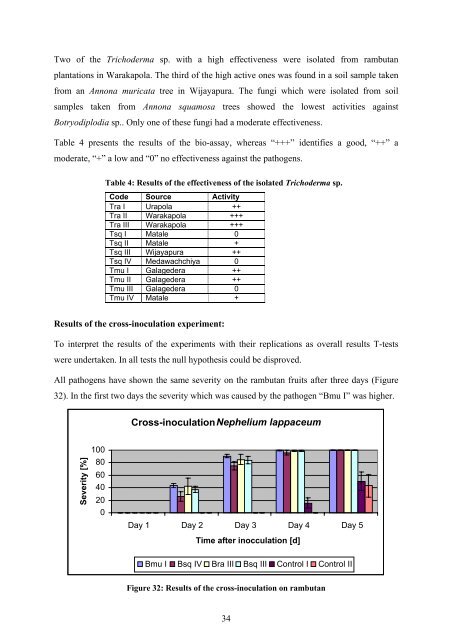Botryodiplodia sp. - Crops for the Future
Botryodiplodia sp. - Crops for the Future
Botryodiplodia sp. - Crops for the Future
Create successful ePaper yourself
Turn your PDF publications into a flip-book with our unique Google optimized e-Paper software.
Two of <strong>the</strong> Trichoderma <strong>sp</strong>. with a high effectiveness were isolated from rambutan<br />
plantations in Warakapola. The third of <strong>the</strong> high active ones was found in a soil sample taken<br />
from an Annona muricata tree in Wijayapura. The fungi which were isolated from soil<br />
samples taken from Annona squamosa trees showed <strong>the</strong> lowest activities against<br />
<strong>Botryodiplodia</strong> <strong>sp</strong>.. Only one of <strong>the</strong>se fungi had a moderate effectiveness.<br />
Table 4 presents <strong>the</strong> results of <strong>the</strong> bio-assay, whereas “+++” identifies a good, “++” a<br />
moderate, “+” a low and “0” no effectiveness against <strong>the</strong> pathogens.<br />
Table 4: Results of <strong>the</strong> effectiveness of <strong>the</strong> isolated Trichoderma <strong>sp</strong>.<br />
Code Source Activity<br />
Tra I Urapola ++<br />
Tra II Warakapola +++<br />
Tra III Warakapola +++<br />
Tsq I Matale 0<br />
Tsq II Matale +<br />
Tsq III Wijayapura ++<br />
Tsq IV Medawachchiya 0<br />
Tmu I Galagedera ++<br />
Tmu II Galagedera ++<br />
Tmu III Galagedera 0<br />
Tmu IV Matale +<br />
Results of <strong>the</strong> cross-inoculation experiment:<br />
To interpret <strong>the</strong> results of <strong>the</strong> experiments with <strong>the</strong>ir replications as overall results T-tests<br />
were undertaken. In all tests <strong>the</strong> null hypo<strong>the</strong>sis could be di<strong>sp</strong>roved.<br />
All pathogens have shown <strong>the</strong> same severity on <strong>the</strong> rambutan fruits after three days (Figure<br />
32). In <strong>the</strong> first two days <strong>the</strong> severity which was caused by <strong>the</strong> pathogen “Bmu I” was higher.<br />
Cross-inoculationNephelium lappaceum<br />
Severity [%]<br />
100<br />
80<br />
60<br />
40<br />
20<br />
0<br />
Day 1 Day 2 Day 3 Day 4 Day 5<br />
Time after inocculation [d]<br />
Bmu I Bsq IV Bra III Bsq III Control I Control II<br />
Figure 32: Results of <strong>the</strong> cross-inoculation on rambutan<br />
34

















